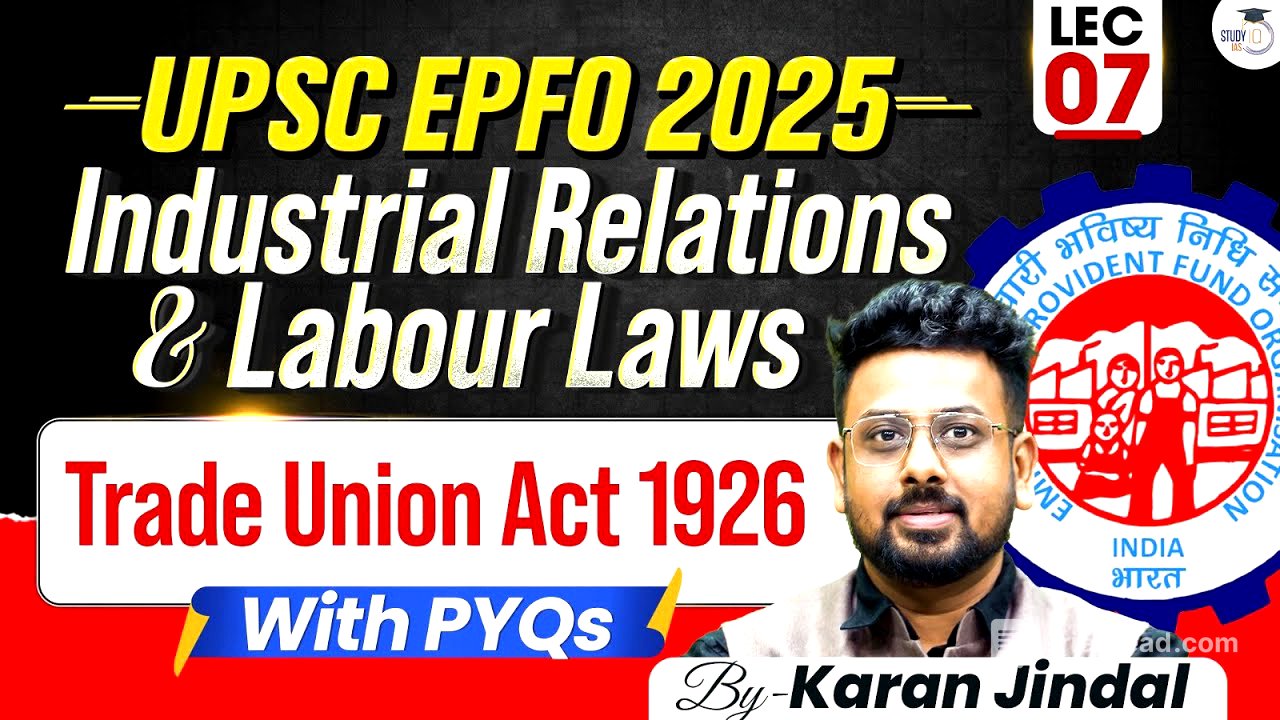TLDR;
This video provides a detailed explanation of the Trade Unions Act of 1926 in India. It covers the history, objectives, and key provisions of the Act, including the registration process, rights and liabilities of trade unions, and the legal status of registered trade unions. The lecture emphasizes the importance of understanding the Act for the EPFO exam and highlights the flaws and the need for the Industrial Relations Code.
- The Trade Unions Act gives collective voice to employees and workmen.
- Both employers and workers organizations can register with the trade union.
- The Trade Unions Act is the only legal framework for the Trade Unions.
Introduction to Trade Unions Act [0:02]
The lecture begins by introducing the Trade Unions Act, emphasizing its importance for the EPFO exam, where at least two questions from this topic appear every year. Trade unions are defined as entities set up by workers, though employers can also participate. The trade union movement emerged with industrialization, as workers sought to assert their rights collectively. The objective of the Trade Unions Act is to provide employees and workmen with a collective voice through union registration, granting them certain rights and privileges. This helps balance the bargaining power between employers and employees, fostering equity in industrial relations.
Objectives and Key Features of the Act [2:22]
The Trade Unions Act aims to provide membership, collective bargaining power, rights, and liabilities to trade union members. Registered trade unions are treated as artificial persons, similar to companies, capable of enjoying rights and being subject to legal action. Both employers and workers' organizations can register under the Act, allowing them to express their views and address conditions affecting their employees. This provision ensures that employers also have a platform to voice their concerns and negotiate collectively.
Historical Context of Trade Unions [6:37]
The trade union movement began in Britain in 1850, post-industrial revolution. In India, a similar setup started around 1875, gaining momentum by 1918-1919. Social workers like Sorabji Shapoorji Bengali drew the British government's attention to the conditions of women and children in Indian factories. NM Lokhande is regarded as the Father of Industrial Relations in India, organizing a labor conference in Bombay in 1884. The International Labour Organization (ILO) was established after World War I due to the poor conditions of workers, further influencing the trade union movement in India. In 1920, the All India Trade Union Congress began with Lala Lajpat Rai, marking a significant step in the organized labor movement in India.
Legal Framework and Other Relevant Acts [12:11]
The Trade Unions Act of 1926 is the primary legal framework for trade unions in India, providing workmen the right of association and organization. Besides this central act, other laws like the Bombay Industrial Relations Act of 1946 and the Maharashtra Recognition of Trade Unions and Prevention of Unfair Labour Practices Act of 1971 also govern trade unions. The Trade Unions Act is a central act created by the Parliament, while state governments create laws around it since labor is a concurrent subject. Registration under the Trade Union Act grants rights and privileges that are otherwise unavailable, offering protection and collective bargaining strength.
Definition and Scope of Trade Unions [15:35]
A trade union is defined as a combination, whether temporary or permanent, formed by workmen and employers to regulate relations between workmen and employers, or between workmen and workmen, or between employers and employers. The purpose is to ensure predictability, security, and equity in industrial relations. This definition aligns with the principles outlined in the Industrial Disputes Act, addressing disputes between workmen, employers, or both. The Act applies throughout India and includes federations of two or more trade unions.
Registration Process and Requirements [19:18]
To register a trade union, a minimum of seven people are required to apply to the Registrar or Deputy Registrar appointed by the government. The applicants must be employed in the organization. The minimum number of workmen required for registration is either 10% of the total workmen or 100, whichever is less. For example, if there are 3,000 employees, 100 workmen are needed, while if there are 300 employees, only 30 are required. However, regardless of the percentage, at least seven people working in the organization must apply. The Labour Commission has recommended that trade unions in the unorganized sector should also be registered, even without a formal employer-employee relationship, though there is no clarity on this yet.
Application Details and Conditions for Registration [25:40]
The application to the registrar must include the names, occupations, and addresses of the members, the name and address of the trade union's head office, and the titles, names, ages, and occupations of the office bearers. If the trade union has been in existence for more than a year, a statement of assets and liabilities must also be provided. At least 50% of the members must be connected to the industry, and no more than 50% of the members of the Executive Committee can be outsiders. The registrar will review the application and may suggest changes if the name clashes with an existing trade union.
Legal Status, Dissolution, and Cancellation of Trade Unions [30:12]
A registered trade union is a body corporate capable of suing and being sued, providing a layer of protection to its members. Legal actions are taken against the trade union, not its individual members. The trade union can own and administer property, and civil suits or legal proceedings may not be initiated against a registered trade union under certain conditions, primarily those outlined in the Industrial Disputes Act. A trade union can be dissolved if the members and secretary provide written notice to the Registrar, and the distribution of assets is done according to the rules. Registration can be cancelled if the certificate was obtained by fraud or mistake, or if the trade union ceases to have the required minimum number of members, a rule enforced since 2002.
Registered Office, Name Change, and Penalties [34:27]
The registered office is the head office of the union, and any change of address must be communicated to the Registrar in writing within 14 days. To change the name of a trade union, the consent of at least 2/3 of the total members is required, and the change must be signed by seven people and the secretary. Penalties for false entries to the Registrar can be up to ₹500, while incorrect information incurs a fine of ₹200.
Membership and Office Bearer Requirements [37:16]
The minimum age to become a member of a trade union is 15 years, aligning with child labor laws. To become an office bearer, the minimum age is 18 years. At least 50% of the office bearers must be engaged in the industry, while the remaining 50% can be outsiders.
Obligations and Rights of Trade Unions [38:51]
Trade unions have obligations, including maintaining account books and membership registers, and submitting annual income statements to the Registrar by December 31st. Registration is optional but necessary to gain rights. Trade unions have the right to appeal against orders, demonstrate collectively, and maintain a general fund for various purposes, such as salaries, legal proceedings, trade disputes, educational and social benefits, and compensation to members. A separate political fund can be used for members running for elections.
Immunities and Amalgamation of Trade Unions [45:03]
Registered trade unions have civil immunity for matters falling under trade disputes, protecting members and office bearers. This includes immunity from civil proceedings if members are induced to break employment contracts. To amalgamate with another trade union, at least 50% of the members' votes are required, with 60% of those voting in favor. This must be submitted to the registrar.
Case Study and Recognition Issues [47:54]
A case study involving a dispute at a Samsung factory in South India highlights a significant flaw in the Trade Union Act: employers are not obligated to recognize trade unions. Even with registration, employers can refuse to acknowledge and negotiate with the union. This issue underscores the need for the Industrial Relations Code, which aims to address this gap. The right to form a trade union is a fundamental right under Article 19(1)(C) of the Indian Constitution, but legal recognition does not guarantee compulsory recognition by employers.
Conclusion and Additional Information [53:34]
The lecture concludes by summarizing the key aspects of the Trade Unions Act of 1926 and its limitations. The Industrial Relations Code is proposed to address the lack of mandatory recognition by employers, though its enforcement is still pending. State-level acts, such as those in Maharashtra, provide additional regulations. The lecture also promotes upcoming EPFO live batches, offering extensive classes and practice materials.









